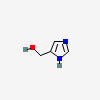Imidazole-4-methanol
- 822-55-9
- IMIDAZOLE-4-METHANOL
- (1H-Imidazol-4-yl)methanol
- 4-(Hydroxymethyl)imidazole
- 1H-Imidazole-4-methanol
- Create:2005-03-25
- Modify:2025-01-11

- 822-55-9
- IMIDAZOLE-4-METHANOL
- (1H-Imidazol-4-yl)methanol
- 4-(Hydroxymethyl)imidazole
- 1H-Imidazole-4-methanol
- 1H-imidazol-5-ylmethanol
- 1H-Imidazol-4-ylmethanol
- (3H-Imidazol-4-yl)-methanol
- 1H-Imidazole-5-methanol
- (1H-imidazol-4-yl)-methanol
- 4-imidazolemethanol
- 4(5)-(Hydroxymethyl)imidazole
- 4-HYDROXYMETHYLIMIDAZOLE
- (1H-imidazol-5-yl)methanol
- CHEBI:28182
- QD0132T507
- 4(5)-Hydroxymethylimidazole
- 1H-Imidazol-4-ylmethanol; 4-(Hydroxymethyl)imidazole; 4-Imidazolylmethanol; 4-Methylol-1H-imidazole
- NSC-39016
- 4-hydroxymethyl imidazole hydrochloride
- UNII-QD0132T507
- MZ0
- 4-imidazole methanol
- 5-hydroxymethylimidazole
- 4-hydroxymethyl imidazole
- 4-Methylol-1H-imidazole
- Lopac-H-1877
- 5-(hydroxymethyl)imidazole
- 4-IMIDAZOLYLMETHANOL
- C05562
- 1H-imidazol-4-yl-methanol
- imidazole, 4-hydroxymethyl-
- Lopac0_000603
- 1H-Imidazol-4-ylmethanol #
- 4(5)-Hydroxymethyl imidazole
- 4-(hydroxymethyl)-1H-imidazole
- CHEMBL1397797
- imidazole, 4(5)-hydroxymethyl-
- DTXSID40231619
- IMIDAZOLE-4(OR 5)-METHANOL
- MFCD00266718
- AKOS005258761
- AKOS015951052
- 4(5)-(Hydroxymethyl)imidazole, 97%
- CCG-204692
- PB24669
- SDCCGSBI-0050585.P002
- NCGC00015502-01
- NCGC00015502-02
- NCGC00015502-03
- NCGC00015502-04
- NCGC00015502-05
- NCGC00093363-02
- AC-23132
- AS-58725
- PD034373
- DB-032007
- CS-0008531
- EN300-50616
- H67433
- W10530
- AB-131/25126047
- Q-101887
- Q-103115
- Q27103551
- Z234898057
98.9 999
81 674
98.2 1
38.8 1
40.9 1
81.1 999
99 24
54.1 5
82.8 1
80.1 1

H315 (100%): Causes skin irritation [Warning Skin corrosion/irritation]
H319 (100%): Causes serious eye irritation [Warning Serious eye damage/eye irritation]
H335 (100%): May cause respiratory irritation [Warning Specific target organ toxicity, single exposure; Respiratory tract irritation]
P261, P264, P264+P265, P271, P280, P302+P352, P304+P340, P305+P351+P338, P319, P321, P332+P317, P337+P317, P362+P364, P403+P233, P405, and P501
(The corresponding statement to each P-code can be found at the GHS Classification page.)
Aggregated GHS information provided per 39 reports by companies from 2 notifications to the ECHA C&L Inventory. Each notification may be associated with multiple companies.
Information may vary between notifications depending on impurities, additives, and other factors. The percentage value in parenthesis indicates the notified classification ratio from companies that provide hazard codes. Only hazard codes with percentage values above 10% are shown.
Skin Irrit. 2 (100%)
Eye Irrit. 2A (100%)
STOT SE 3 (100%)
Patents are available for this chemical structure:
https://patentscope.wipo.int/search/en/result.jsf?inchikey=QDYTUZCWBJRHKK-UHFFFAOYSA-N
- CAS Common ChemistryLICENSEThe data from CAS Common Chemistry is provided under a CC-BY-NC 4.0 license, unless otherwise stated.https://creativecommons.org/licenses/by-nc/4.0/1H-Imidazole-5-methanolhttps://commonchemistry.cas.org/detail?cas_rn=822-55-9
- ChemIDplus4-(Hydroxymethyl)imidazolehttps://pubchem.ncbi.nlm.nih.gov/substance/?source=chemidplus&sourceid=0000822559ChemIDplus Chemical Information Classificationhttps://pubchem.ncbi.nlm.nih.gov/source/ChemIDplus
- EPA DSSTox4-(Hydroxymethyl)imidazolehttps://comptox.epa.gov/dashboard/DTXSID40231619CompTox Chemicals Dashboard Chemical Listshttps://comptox.epa.gov/dashboard/chemical-lists/
- European Chemicals Agency (ECHA)LICENSEUse of the information, documents and data from the ECHA website is subject to the terms and conditions of this Legal Notice, and subject to other binding limitations provided for under applicable law, the information, documents and data made available on the ECHA website may be reproduced, distributed and/or used, totally or in part, for non-commercial purposes provided that ECHA is acknowledged as the source: "Source: European Chemicals Agency, http://echa.europa.eu/". Such acknowledgement must be included in each copy of the material. ECHA permits and encourages organisations and individuals to create links to the ECHA website under the following cumulative conditions: Links can only be made to webpages that provide a link to the Legal Notice page.https://echa.europa.eu/web/guest/legal-notice(1H-imidazol-4-yl)methanolhttps://echa.europa.eu/substance-information/-/substanceinfo/100.156.838(1H-imidazol-4-yl)methanol (EC: 628-579-0)https://echa.europa.eu/information-on-chemicals/cl-inventory-database/-/discli/details/161526
- FDA Global Substance Registration System (GSRS)LICENSEUnless otherwise noted, the contents of the FDA website (www.fda.gov), both text and graphics, are not copyrighted. They are in the public domain and may be republished, reprinted and otherwise used freely by anyone without the need to obtain permission from FDA. Credit to the U.S. Food and Drug Administration as the source is appreciated but not required.https://www.fda.gov/about-fda/about-website/website-policies#linking4-(HYDROXYMETHYL)IMIDAZOLEhttps://gsrs.ncats.nih.gov/ginas/app/beta/substances/QD0132T507
- ChEBIImidazole-4-methanolhttps://www.ebi.ac.uk/chebi/searchId.do?chebiId=CHEBI:28182
- ChEMBLLICENSEAccess to the web interface of ChEMBL is made under the EBI's Terms of Use (http://www.ebi.ac.uk/Information/termsofuse.html). The ChEMBL data is made available on a Creative Commons Attribution-Share Alike 3.0 Unported License (http://creativecommons.org/licenses/by-sa/3.0/).http://www.ebi.ac.uk/Information/termsofuse.htmlChEMBL Protein Target Treehttps://www.ebi.ac.uk/chembl/g/#browse/targets
- Crystallography Open Database (COD)LICENSEAll data in the COD and the database itself are dedicated to the public domain and licensed under the CC0 License. Users of the data should acknowledge the original authors of the structural data.https://creativecommons.org/publicdomain/zero/1.0/
- The Cambridge Structural Database
- IUPAC Digitized pKa Datasetimidazole, 4-hydroxymethyl-https://github.com/IUPAC/Dissociation-Constants
- Japan Chemical Substance Dictionary (Nikkaji)
- KEGGLICENSEAcademic users may freely use the KEGG website. Non-academic use of KEGG generally requires a commercial licensehttps://www.kegg.jp/kegg/legal.html
- MassBank Europe4-Hydroxymethylimidazolehttps://massbank.eu/MassBank/Result.jsp?inchikey=QDYTUZCWBJRHKK-UHFFFAOYSA-N
- MassBank of North America (MoNA)LICENSEThe content of the MoNA database is licensed under CC BY 4.0.https://mona.fiehnlab.ucdavis.edu/documentation/license
- Metabolomics WorkbenchImidazole-4-methanolhttps://www.metabolomicsworkbench.org/data/StructureData.php?RegNo=51610
- NIST Mass Spectrometry Data CenterLICENSEData covered by the Standard Reference Data Act of 1968 as amended.https://www.nist.gov/srd/public-law1H-Imidazole-4-methanolhttp://www.nist.gov/srd/nist1a.cfm
- SpectraBase1H-Imidazole-4-methanolhttps://spectrabase.com/spectrum/B10PHtKK8I41H-Imidazole-4-methanolhttps://spectrabase.com/spectrum/480hyb0PoFmImidazole-4-methanolhttps://spectrabase.com/spectrum/27JSUl8YOANImidazole-4-methanolhttps://spectrabase.com/spectrum/HjoUGVbzsFV
- Protein Data Bank in Europe (PDBe)
- RCSB Protein Data Bank (RCSB PDB)LICENSEData files contained in the PDB archive (ftp://ftp.wwpdb.org) are free of all copyright restrictions and made fully and freely available for both non-commercial and commercial use. Users of the data should attribute the original authors of that structural data.https://www.rcsb.org/pages/policies
- Springer Nature
- Thieme ChemistryLICENSEThe Thieme Chemistry contribution within PubChem is provided under a CC-BY-NC-ND 4.0 license, unless otherwise stated.https://creativecommons.org/licenses/by-nc-nd/4.0/
- Wikidata4-(hydroxymethyl)imidazolehttps://www.wikidata.org/wiki/Q27103551
- PubChem
- Medical Subject Headings (MeSH)LICENSEWorks produced by the U.S. government are not subject to copyright protection in the United States. Any such works found on National Library of Medicine (NLM) Web sites may be freely used or reproduced without permission in the U.S.https://www.nlm.nih.gov/copyright.html4-imidazolemethanolhttps://www.ncbi.nlm.nih.gov/mesh/2009545
- GHS Classification (UNECE)GHS Classification Treehttp://www.unece.org/trans/danger/publi/ghs/ghs_welcome_e.html
- MolGenieMolGenie Organic Chemistry Ontologyhttps://github.com/MolGenie/ontology/
- PATENTSCOPE (WIPO)SID 388358752https://pubchem.ncbi.nlm.nih.gov/substance/388358752



